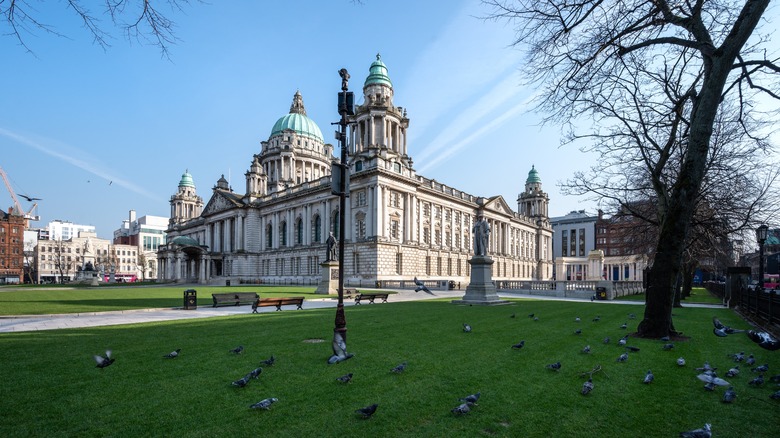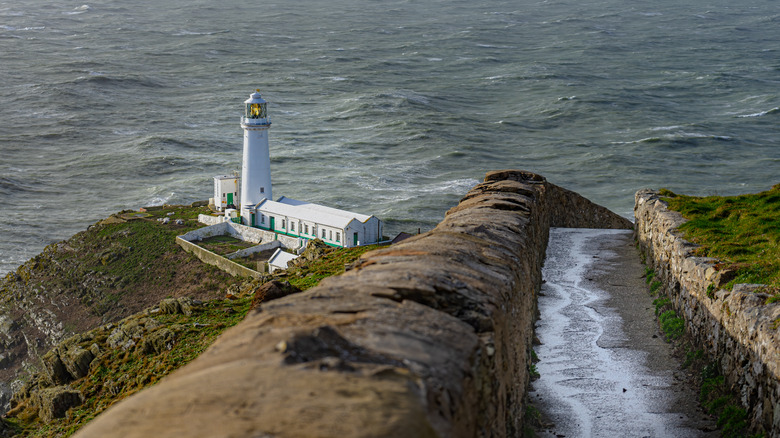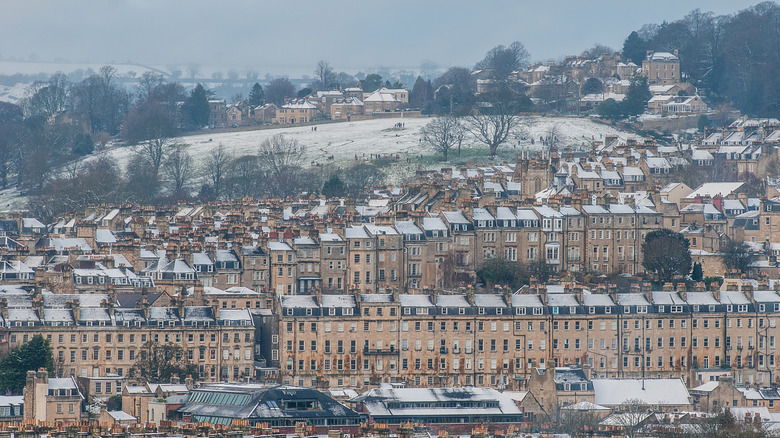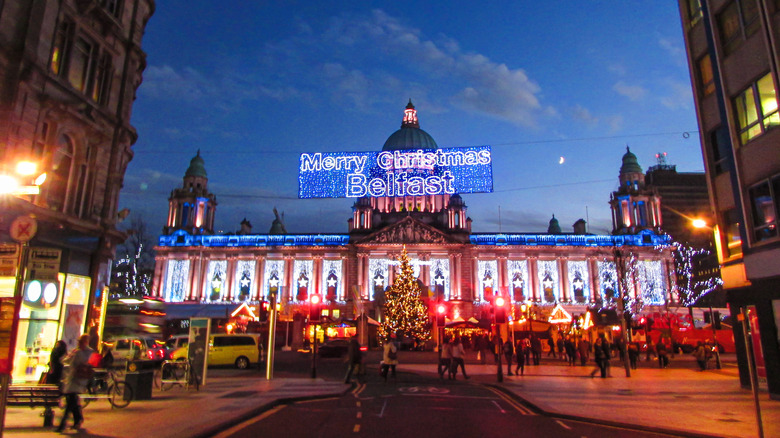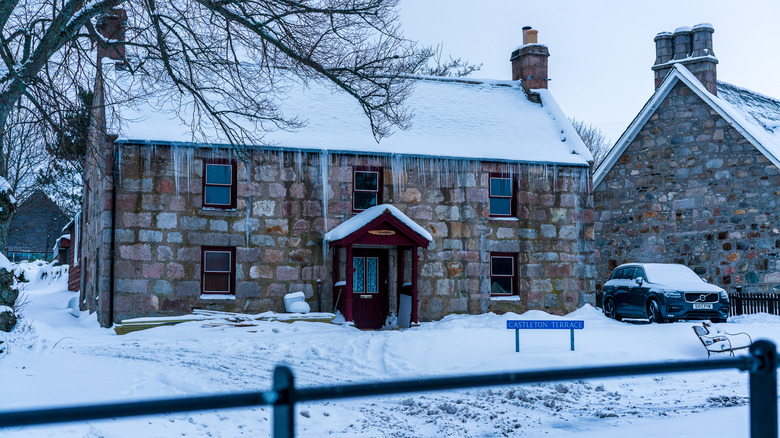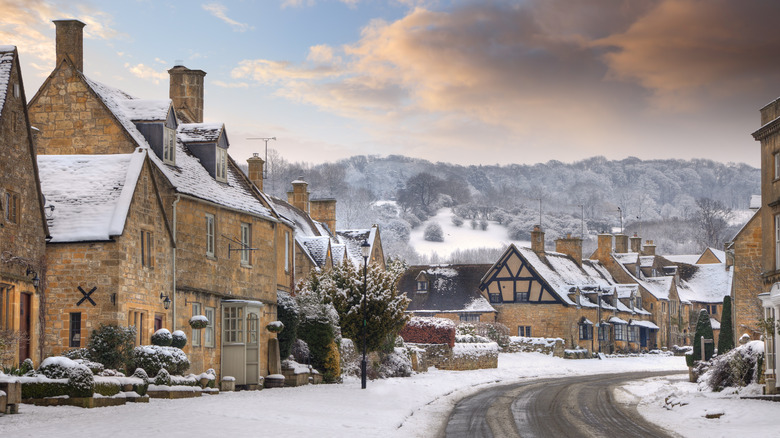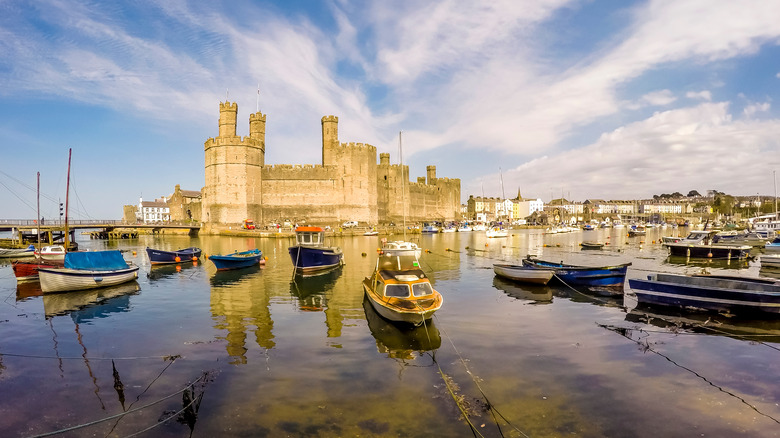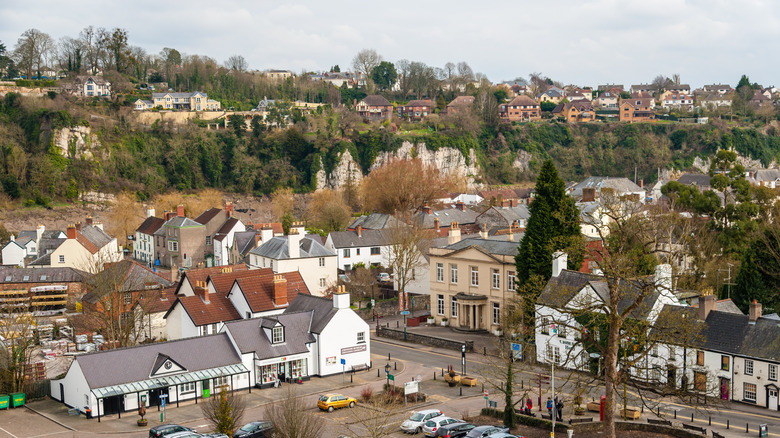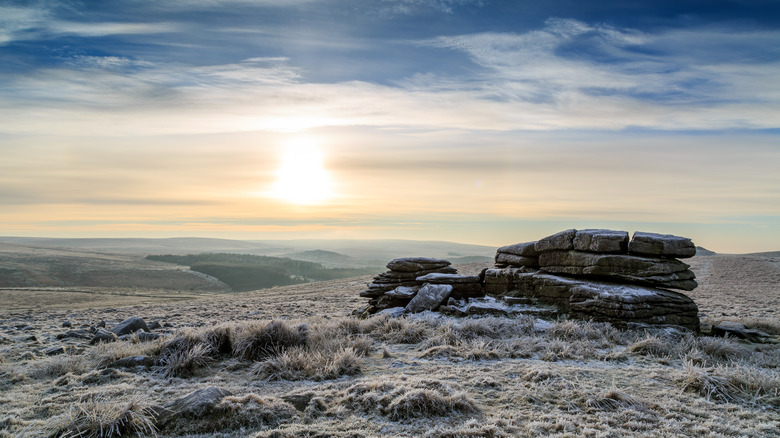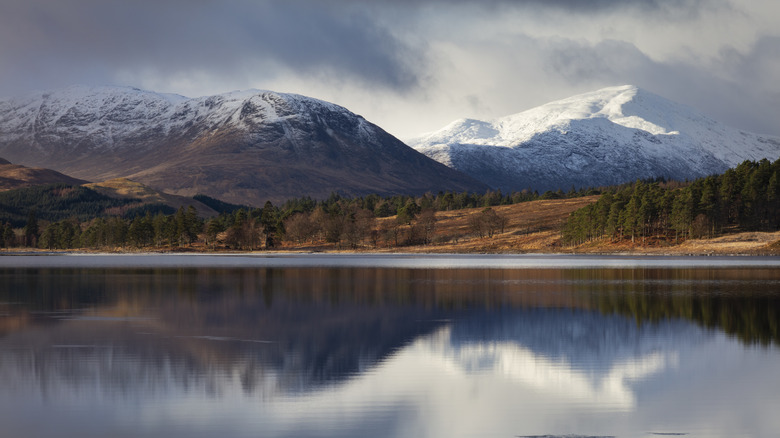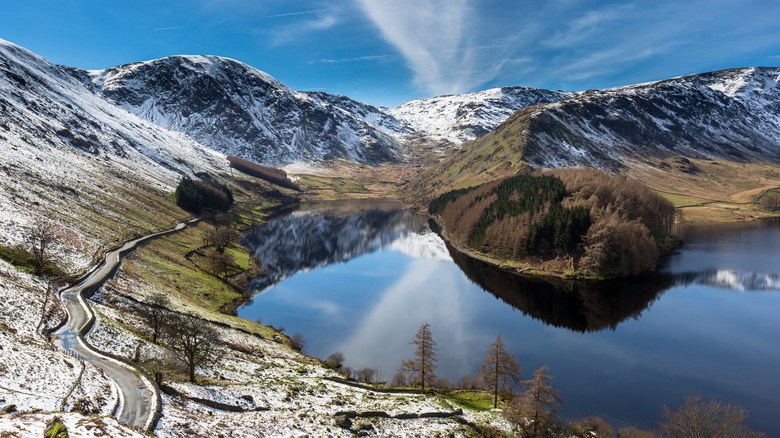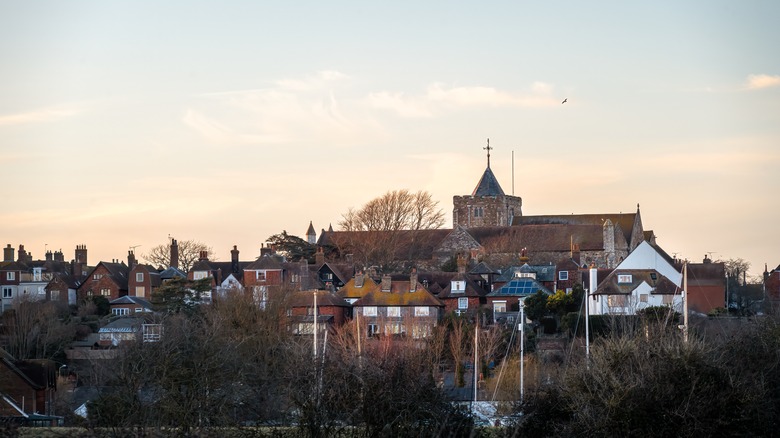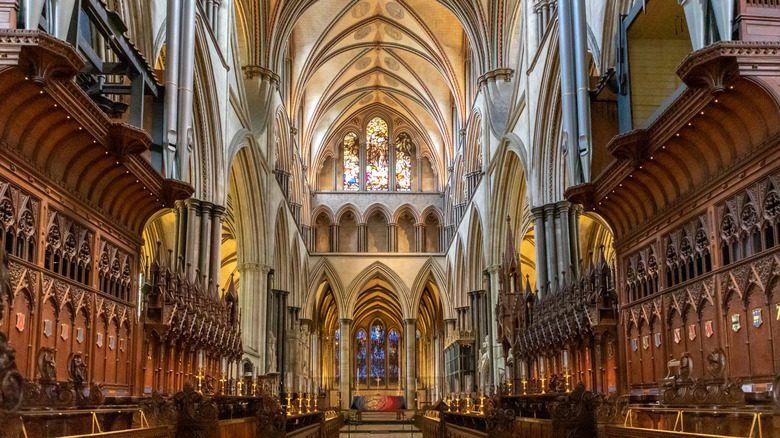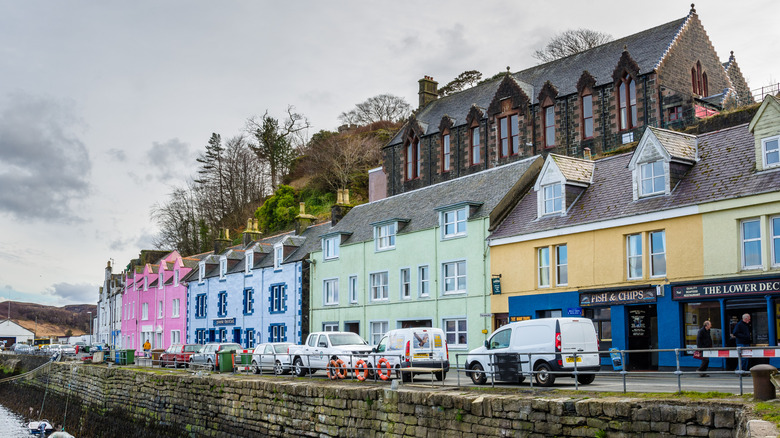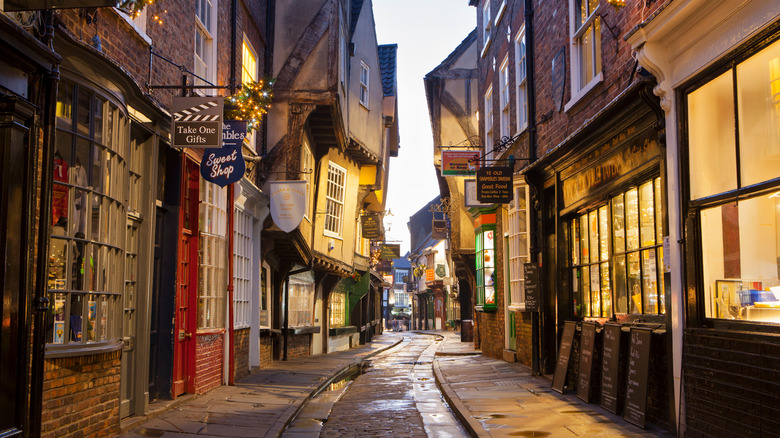Underrated UK Destinations For A Picture-Perfect Winter Getaway, According To Tourists
A popular destination for American travelers in the summer, the United Kingdom also offers surprising appeal in the winter. At that time of the year, the countries of the U.K. — England, Northern Ireland, Scotland, and Wales — quiet down, tourism slows, traffic lightens, and deals are more prevalent. Certain locations seem obvious choices for winter trips to the U.K., places like Edinburgh and its historic buildings and compact center, London with its myriad attractions and bright lights, and coastal retreats like Brighton, where wanders along the waterfront are beloved by locals and visitors alike.
But many other, lesser-known destinations in the U.K. are just as enjoyable in the winter, where pretty architecture and fascinating seasonal diversions ensure that travelers have plenty to keep them busy. Using information gleaned from personal knowledge and various sources, including blogs and tourism boards, we've compiled a list of underrated places in the U.K. that promise a fabulous winter escape.
Anglesey
Set off the northwest coast of Wales and accessible from the mainland by road, Anglesey has a rich history and plenty to explore. It's often overlooked in favor of other Welsh destinations like the bustling capital of Cardiff or the picturesque coastal town of Conwy, but Anglesey is a gem waiting to be discovered. Visitors usually access the island via the spectacular Menai Suspension Bridge, built in the 1820s as the first suspension bridge on the planet, a fact worth bragging about. One of the most appealing aspects of the island is the selection of lighthouses, with South Stack the most famous. In the winter, buffeted by coastal winds and with a lack of people around them, they seem peculiarly remote and stoic.
Winter walks along the various parts of the Anglesey Coastal Path are a great way to experience some of the lighthouses on the island, as well as the rock arches of Bwa Gwyn and Bwa Du. One of the most picturesque spots on Anglesey is Llanddwyn Island, which is actually a rocky headland. Here, an old church is dedicated to Saint Dwynwen, Wales' patron saint of lovers; visit it on January 25, St. Dwynwen's Day, the Welsh equivalent of Valentine's.
Bath
Despite being a filming location for the TV show "Bridgerton" and welcoming throngs of visitors in the warmer months, Bath has always retained a small-town feel. It's home to a prestigious university and has some of the most striking Georgian architecture anywhere in the world, but this UNESCO World Heritage site has less than 100,000 permanent residents. During the winter, the crowds thin out markedly, leaving the town much less congested for visitors and allowing them to admire the gorgeous buildings and festive attractions with much less hassle. A fine place to enjoy a crisp winter day is the Royal Crescent, a striking, curling sweep of a road where the Georgian buildings look as precise and glorious as they did when they first debuted in the late 1700s.
Toward the end of the year, the Bath Christmas Market begins in late November and promises shoppers plenty of joyful festive cheer. When the mercury dips, travelers can head to the Roman baths that give the town its name, with the Thermae Bath Spa and its warm, mineral-rich waters just one of the many spa options here. Outside Bath, the Festival of Light takes place at Longleat Safari and Adventure Park and runs until early January. It has enormous lanterns that are a luminous wonder to behold, and Longleat's winter safaris run throughout the season.
Belfast
While the Republic of Ireland frequently receives plaudits as a delightful vacation escape, known for its friendly folk and gorgeous greenery, Northern Ireland tends to be given short shrift, overlooked in favor of its southern brethren. But the north, home to several filming locations for "Game of Thrones," is an equally compelling destination. Many of the filming sites sit outside the capital, Belfast, but the city is filled with things to do during the winter. The Belfast Christmas Market, set next to the stately City Hall, is not to be missed, with more than 100 stalls where craft items, food, and warming drinks appear in generous amounts. There are sparkling lights everywhere, a carousel, and even a helter-skelter slide, making the whole endeavor a true winter wonderland.
Another attractive alternative in the colder climes is the Candlelight Concert series, which usually runs from mid-January to mid-February. It features some of the city's top musicians performing live in many of Belfast's most famous buildings, with the shows lit by candle. Expect a gorgeously intimate, atmospheric, and photogenic experience. Ice hockey fans can book rink-side seats for Belfast Giants home games, one of the most successful clubs in the history of the Elite Ice Hockey League.
Braemar
Think of areas of nature in the United Kingdom, and the Peak District, the Cotswolds, New Forest, and the White Cliffs of Dover by the English Channel might come to mind. But what might surprise readers is that the largest national park in the U.K. is Cairngorms National Park, located in the rugged north of Scotland. This is a place of wild, untouched beauty, with exceptional hiking and pretty wildlife, far from any major city.
The village of Braemar is a quaint hamlet that sits in the heart of the park, a tranquil town that fills to the brim each September for the annual Highland Games (even the Royal Family usually attends) but returns to its serene state by the time winter rolls around. It's the kind of place where you'll quickly get to know the locals, and it is a good base for exploring the park. Lace up your hiking boots, and you'll find trails that rise high above jagged lakes and landscapes of undulating hills and mountains, quite possibly topped by a dusting of snow that will make the heart melt.
Broadway
Officially designated as an Area of Outstanding Natural Beauty, the Cotswolds spread across almost 800 square miles, extending over six counties in England. It really is a breathtaking part of the U.K., with rolling countryside, pretty villages, and infinite charm. The small village of Broadway is set right in the heart of that pastoral bliss, yet often appears way down the list of places to visit in the Cotswolds, trailing spots like Cirencester, Upper Slaughter, or Bibury. But Broadway is a jewel box of a place, a quintessential rural England hamlet that also has an extraordinary attraction.
The Broadway Tower is a landmark in the region, with turrets, gargoyles, and balconies all adding a little flair to this centuries-old lookout. It sits on Beacon Hill, one of the highest natural parts of the Cotswolds, and shoots up more than 300 feet in the air. From its summit, views, on a clear day, reach out as far as 60 miles away. On a crisp winter morning, perhaps with some lingering mist or fog in the air or a layer of snow pasted on the hills, a visit to the top of the tower can make visitors feel that they are floating atop a mythical, mystical realm. In the heart of the town, winter visitors can check out Christmas-time shopping, with mulled wine and roasted chestnuts for sale, or stop by the town's design museum or art gallery.
Caernarfon
Caernarfon, a town that sits across the Menai Strait from the isle of Anglesey, is another Welsh wonder. It's a surefire hit in the summer, with tourists drawn in by its incredible castle, but come winter, the town takes on a sleepier air, with the waterfront and lanes and alleys notable for their quietude. But Caernarfon is far from dead in the winter, evidenced by a lively Christmas market. In 2023, for instance, the market was bigger than ever, held in five locations across the town, creating a long stream of festive shopping accompanied by seasonal music and choral renditions.
The castle, of course, should not be missed, a defining feature of Caernarfon, taking on the role of both a robust fortress and a dreamy palace. Sitting on the River Seiont, it is perhaps the most impressive of Edward I's castles in the area. The complex took almost half a century to complete and features high walls, an impregnable castle, and a dock so boats could have access. Visitors could easily spend a day wandering around the grounds and its broad ramparts in the knowledge that royalty stood in this very spot hundreds of years earlier.
Chepstow
Another castle is the treat of this town overlooking the River Wye in Wales. Visitors to the area often gravitate to the nearby cities of Bristol (England) across the River Severn and the Welsh capital of Cardiff, to the west. And yet, Chepstow is a picturesque destination with a fascinating past, making it a worthy place for a getaway any time of year. Winter is incredibly alluring, with mist often hovering in the air and bare trees appearing like live works of art. Chepstow Castle has been around for centuries, built in the era of the Normans, and its location atop the River Wye only adds to its glamor — though, historically, the setting provided a sound tactical advantage to those inside.
It is believed to be the oldest stone castle in the United Kingdom from the post-Roman age, and its rounded turrets recall the rooks on a chess board. More of the town's past can be discovered at the Chepstow Museum, where exhibits trace the town's link to shipbuilding and the wine business. Architecture from the Georgian and Victorian periods fills the center of Chepstow, structures that today house independent shops and fabulous boutiques. And for active types, the Wye Valley Walk is a rewarding winter excursion, a 17-mile route along the river that slips through woods, and is a study in serenity.
Dartmoor
Residing across a vast slash of Southwestern England, Dartmoor is an arena of variegated environments, with pastoral hills that rise and fall, plains of hardy heather and gorse bush, granite hills that break up the horizon and also provide fabulous lookout points, and verdant valleys that slip away as far as the eye can see. Travelers to this part of the country often head straight to the coast, especially the nearby seaside haunt of Torquay, but Dartmoor National Park is a place of unassuming majesty.
The hiking is phenomenal, and at times, wandering high above hills that seem to roll forever, you will feel like you are on top of the world. Dartmoor becomes even more atmospheric in the winter, when mist and moisture cling to the trees, and the air is still and enigmatic, with ancient stone walls and remnants of homes from the bronze age adding to the mystery of the place. Among the highlights is Wistman's Wood, where giant granite rocks and gnarled tree limbs in this oak wood are covered in soft moss and lichen; when shrouded in mist, they look like something straight out of the "Lord of the Rings." At night, the stargazing in Dartmoor is out of this world, literally.
Glen Coe
A beautiful section of the Scottish Highlands, just south of Ben Nevis, the tallest mountain in the U.K., Glen Coe is a valley of striking natural beauty, wild, rugged, and sumptuously scenic. The village of Glencoe is the gateway to the glen itself, and it's often overlooked, seen as simply a launching pad to the adventures awaiting in the great outdoors. However, it is charming, with plenty of places to stay, including quaint cottages and fine spots to eat seafood caught off the Scottish coast. In the winter, the scenery is silently majestic, and the heaths, waterfalls, valleys, and mountains take on an aura of brooding untapped power.
There are many reasons why winter is the most enjoyable time to visit Glen Coe. One very practical point is the lack of midges, those small flies that are hard to see, travel in swarms and can have an incredibly itchy bite, and are ubiquitous in the summer. There are no crowds in the winter, helping to amplify the pristine qualities of the landscape, and since winter days are shorter, the light shifts much more quickly and is more compressed, making changes in the interplay between light and shadow much more apparent. And, for sports enthusiasts, the choices in winter are enviable, with serene mountain hikes, ice climbing, and ski slopes all on offer.
Lake District
This area of lakes in the north of England is a dependable summer vacation spot. And yet, come the colder time of the year, the vacation homes, caravan parks, and bed and breakfasts empty out. The Lake District scenery, however, remains unchanged, an entrancing tableau of still lakes, craggy hills, long valleys, thick forests, and inviting villages. In the winter, when tourism numbers drop, the scenery feels like it was weaved together just for you, and the quiet and solitude are haunting and memorable.
When the mercury dips below freezing, the lakes can ice over, and if there is snow on the trees, coating the barren branches, then the montage is truly a winter wonderland. There are several winter walks that will bring the stunning surroundings into view, with Easedale Tarn among the top choices. It passes through farmland, up hills, past streams, and shadowing a tarn (or small mountain lake). During the winter, bridges en route might have icicles hanging from them, and the snow-specked hillsides reflected in the still lake are fantastic photo subjects.
Rye
This pretty town near England's south coast is a traditional warm-weather haven, with sunbathers packing the area's sand and stone beaches in the summer before returning to Rye to enjoy its hilly setting and intimate countryside ambiance. During the winter, when the beaches are no longer the focus, Rye promises other lesser-known dulcet charms. The Christmas festival begins in November and features late-night shopping, the lighting of a grand tree, music shows, street entertainers, and races down Rye's main street, a fun, festive way to get into the holiday spirit.
Walkers will be drawn to the Rye Harbour Nature Reserve, an important area of wetlands where birds and plants thrive, which is also home to ancient military structures. Back in the town center, travelers can wander the independent boutiques that flank cobblestoned streets or have a warming tipple in places like the Mermaid Inn, a lodging with a bar and restaurant that has stood here for more than 600 years.
Salisbury
The summer and winter solstices are important snapshots of the year at Stonehenge, a monument built thousands of years ago. Even though hundreds of people will descend upon the mystical rocks in the west of England on that cool winter solstice morning, nearby Salisbury largely flies under the radar. But the medieval town is a gripping destination. The ancient cathedral is its focal point, and come the winter, when everything around them stills, you can wander around the old, historic buildings that appear throughout the town and almost imagine that you've traveled back in time to the era when they were newly built.
Salisbury Cathedral is a thing of transcendent beauty, with the tallest spire in Britain and grand, stately cloisters on the grounds. Visitors will see intricate, buoyant stained-glass windows and ornately carved shrines. There is even an original copy of the Magna Carta on display at the cathedral — the document from the 1200s outlined the rights of individuals and is seen as a cornerstone for the establishment of democracy. On a frosty morning or after snowfall, the cathedral and its grounds are stunning.
Skye
Located off the west coast of Scotland, Skye is an island with a jagged coastline that is home to Portree, one of the most picturesque towns in the whole of the United Kingdom. The capital of Skye, Portree boasts an Instagram-primed waterfront, thanks to its row of pastel-colored homes that line the harbor. In the winter, Skye transforms, and tourists all but disappear from the island. That is their loss because, during the colder months, the landscapes here take on a magical, otherworldly aura. Sure, it can get wet and windy here — the island is by the sea, after all — but visitors dressed appropriately, with thick socks and waterproof walking boots essential, will have their pick of crowd-free adventures.
The beaches, coastal trails, and hilly interiors will be empty, and when the sun hits the rust-colored heather that blankets the landscape or glints off a fresh dusting of snow, the scenery becomes spellbinding. Add to that the ever-shifting clouds and the shortened daylight hours, and the whole experience is laden with deep, dramatic weight.
York
This town in Northern England is a popular destination, with millions visiting each year. But come the winter months, the numbers drop sharply, leaving you ample room to maneuver among the centuries-old buildings and narrow alleys. The history of York oozes from every pore of the city, founded almost 2,000 years ago by the Romans, with some ruins from that era still existing today. The Vikings also settled here, naming the town Jorvik, though the most evident imprint on the city's architecture was the Medieval era, seen in the town walls, gates, and venerable streets. Wander around York in the winter, where snow is very much possible, and you will see grand Georgian homes or marvel at the central train station that dates from Victorian times.
One of the most picturesque streets, the Shambles is a great place for Christmas shopping among the small boutiques and good for a bite to eat or something soothing to drink. From cobblestoned streets underfoot to buildings whose upper floors hang overhead, the street looks and feels as though it's been frozen in time. York also has a lively Christmas market, and no visit would be complete without a stop at York Minster, a cathedral that is over 1,000 years old and whose stained-glass windows are renowned across the globe.
Methodology
To put together this list of underrated winter destinations in the U.K., we drew on our knowledge of the country. This information was supported by extensive research on travel blogs, hotel sites, and official tourism authority pages.
